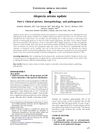TLDR Alopecia areata mainly affects young people, often showing as patchy hair loss on the scalp.
The study evaluated the clinical and demographic patterns of alopecia areata (AA) in 410 patients, aged 1 to 74 years, with a nearly equal gender distribution. The most common age of onset was 21-30 years, and the most frequent presentation was multilocular patches, with patchy AA being the most prevalent type. Eyebrow involvement was more common in the ophiasis group, and nail involvement, particularly pitting, was observed in 45.4% of patients. A history of previous AA episodes was noted in 32.4% of patients, and the scalp was the most commonly affected area (76.8%). Atopic dermatitis was the most common associated disease (5.8%), with other conditions like thyroid disorders, vitiligo, and diabetes also observed. The study concluded that AA predominantly affected younger individuals and aimed to correlate these findings with other studies and hypotheses.
 67 citations
,
January 2013 in “Indian Journal of Dermatology, Venereology and Leprology”
67 citations
,
January 2013 in “Indian Journal of Dermatology, Venereology and Leprology” The document concludes that alopecia areata is an autoimmune disease without a definitive cure, but treatments like corticosteroids are commonly used.
 391 citations
,
January 2010 in “Journal of The American Academy of Dermatology”
391 citations
,
January 2010 in “Journal of The American Academy of Dermatology” Half of people with Alopecia Areata may see hair regrowth within a year without treatment, but recovery is unpredictable.
161 citations
,
March 1992 in “International Journal of Dermatology” Alopecia areata often starts before age 20, is more common in women, and may have a genetic link with other autoimmune diseases.
September 2020 in “Annals of Punjab Medical College” Alopecia areata in children is more common in boys, mainly affects the scalp, and is linked to genetics and psoriasis.
1 citations
,
February 2020 in “International Journal of Research in Dermatology” Scalp alopecia areata mostly affects young adult males, often starts suddenly, and usually presents as single, patchy lesions.
17 citations
,
August 2016 in “JEADV. Journal of the European Academy of Dermatology and Venereology/Journal of the European Academy of Dermatology and Venereology” Almost half of the men with beard hair loss also developed scalp hair loss within a year.
January 2015 in “Journal of Practical Dermatology” Younger children with alopecia areata often experience more severe hair loss and longer illness, with allergies and nutrient deficiencies playing a role.
 21 citations
,
February 2012 in “Journal of the European Academy of Dermatology and Venereology”
21 citations
,
February 2012 in “Journal of the European Academy of Dermatology and Venereology” Late-onset alopecia areata in Taiwanese patients is more common in women, usually starts at age 57, often involves less than 10% hair loss, and may have a minimal link to thyroid issues.



